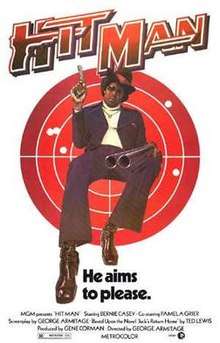Hit Man (1972 film)
Hit Man is a 1972 American crime film directed by George Armitage[2] and starring Bernie Casey, Pam Grier and Lisa Moore.[3] It is based on Ted Lewis' 1970 novel Jack's Return Home,[4] more famously adapted as Get Carter, with the action relocated from England to the United States.
| Hit Man | |
|---|---|
 Theatrical release poster by John Solie | |
| Directed by | George Armitage |
| Produced by | Gene Corman |
| Written by | Ted Lewis |
| Screenplay by | George Armitage |
| Based on | Jack's Return Home by Ted Lewis |
| Starring | Bernie Casey Pam Grier Lisa Moore |
Production company | Penelope Productions, Inc. |
| Distributed by | Metro-Goldwyn-Mayer, Inc. |
Release date |
|
Running time | 90 minutes |
| Country | United States |
| Language | English |
| Box office | $1,190,000 (US rentals)[1] |
Plot
Oakland hitman Tyrone Tackett (Bernie Casey) comes home to southern California for the funeral of his brother Cornell. Cornell left behind his wild daughter Rochelle (Candy All), who rejects Tyrone's offer to live with him. Tyrone befriends his late brother's business partner, Sherwood Epps (Sam Laws), and stays in town to investigate his brother's death. He is threatened by gangsters who tell him to leave town, but they've threatened the wrong man.
Cast
- Bernie Casey - Tyrone Tackett
- Pam Grier - Gozelda
- Lisa Moore - Laural Garfoot
- Bhetty Waldron - Irvelle Way
- Sam Laws - Sherwood Epps
- Candy All - Rochelle Tackett
- Don Diamond - Nano Zito
Production
George Armitage says he never saw Get Carter before making the film. He says Gene Corman gave him a copy of the script with no title and said MGM owned it.[5] Armitage rewrote it to be set in the African American community, and only then did his agent tell him it was Get Carter. Armitage:
I didn't feel at the time that a white director should be directing it. So I met with Bernie [Casey, the film's star], who wanted to direct it, and campaigned for him with Gene, and he said: "I don't want to take a chance on someone who hasn't directed." So he wasn't going to make the picture, and at that point there was a lot of crew and cast involved, and they were friends, so I said: "Okay, I'll do it." There was a great deal of improvisation by the actors, who were bringing me dialogue from the African-American community, and it really worked. Growing up in a racially mixed neighborhood, like I did in Baldwin Hills, I knew a little bit about the culture, but the actors brought so much in terms of dialogue and honesty ... The Colonial Motel up on Sunset worked beautifully for us, and we also shot at a funeral home in southwest L.A., we shot all over there, with a crazy police escort holding traffic on every location. And between locations I'd get in a squad car with these crazy cops and drive 150 mph to the next location, I thought: "God, Roger would be so thrilled with that, that's the way to travel." And I'm so glad we were able to shoot in the Watts Towers, right down there at 103rd.[6]
Reception
The film earned an estimated $1,190,000 in North American rentals in 1973.[1]
See also
References
- "Big Rental Films of 1973", Variety, 9 January 1974 p 60
- "Hit Man". Turner Classic Movies. United States: Turner Broadcasting System. Retrieved March 5, 2018.
- BFI.org
- Ted Lewis (1970). Jack's Return Home (1st ed.). United Kingdom: Michael Joseph Ltd. ISBN 978-0718107307.
- "Interview with George Armitage - Part One". Money Into Light.
- Nick Pinkerton, "Interview with George Armitage", Film Comment 28 April 2015
External links
- Hit Man on IMDb
- Hit Man at Rotten Tomatoes